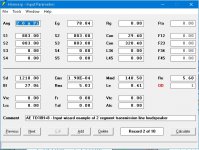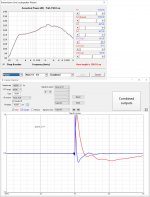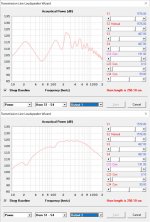I read someone removing bug screen on an altec, couldn't hear any difference.
Based on the size of the throat of the compression driver, that may be 7.5khz impedance bump, but I'm speculating, not calling you out.
Based on the size of the throat of the compression driver, that may be 7.5khz impedance bump, but I'm speculating, not calling you out.
Last edited:
A bunch of us have done it over the decades [me included and recommend it when worthwhile for the intended app] and just depends on one's hearing, the horn it's attached to, etc.. Where it's most noticeable is when using CD horn EQ that significantly shelves down the horn [virtually all non-tube HIFI/HT apps], letting the extreme HF through unattenuated [up to 12 dB boosted in effect] to tonally balance it out over the speaker's entire BW.
GM
GM
I can totally see on paper how a transmission line has the best bass according to many accounts on this board. I'm currently googling brand name studio monitor subwoofers impedance curves but haven't found much. I don't know what models of subwoofer the crowd here considers to be "remarkable". Name some, or drop some "impressive" subwoofer impedance charts.
Altec 411/416/515, JBL 2235, pretty much any vintage woofer with strong motors, low Fs, low Le, with true subwoofers such as the Aura 1808 and a few others I can't recall ATM I've personal experience and from specs, AE TD15H trumps them all WRT impedance IIRC.
Of the bunch, I'll take [4] 1808s to go, thank you very much!
All that said, I imagine there's just as good ones from PD, etc., just haven't kept up with high end drivers like I once did. I bet whoever makes IMAX components have some 'killer' true sub drivers.
GM
I feel like I'm missing one thing....rigidity of the woofer cone....is this even a measurement?
Well, in general, the higher Mmd is, the more rigid it is. The better Q is: how much compression can the suspension handle? Bass TLs need bass horn driver's stiff suspensions [low Vas], high Mmd diaphragms since both are driving high acoustic impedance loads, at least if the goal is to flatten the electrical impedance.
GM
I don’t think the impedance curve of a sub is going to tell you that much about how it sounds.I can totally see on paper how a transmission line has the best bass according to many accounts on this board. I'm currently googling brand name studio monitor subwoofers impedance curves but haven't found much. I don't know what models of subwoofer the crowd here considers to be "remarkable". Name some, or drop some "impressive" subwoofer impedance charts.
Servo Control Technology ....
for your venue, will get you closer to optimal performance than any of the other alternatives you may choose to consider. You get clean, deep bass in a small footprint that can be configured with multiple units to match the listening space you have. In this regard, have a look at units offered by Rythmik Audio • Direct Servo subwoofer products
Some of these units are also reviewed in the reference given earlier.
Regards,
WHG
Oh wow, that website just so happens to have a krk 12s's under review, I'm using 2 right now lol.
dB v2
My model is slightly different though, the output is similar, seems like if I get these subs right, I'm in for a real treat.
for your venue, will get you closer to optimal performance than any of the other alternatives you may choose to consider. You get clean, deep bass in a small footprint that can be configured with multiple units to match the listening space you have. In this regard, have a look at units offered by Rythmik Audio • Direct Servo subwoofer products
Some of these units are also reviewed in the reference given earlier.
Regards,
WHG
@camplo, sorry if i missed it, are you looking for raw sub drivers to build an enclosure around or a proven design/system that is ready to use?
I have an Acoustic Elegance 18h+ that I want to use for a subwoofer. I have grown to respect the Transmission Line enclosure, there are many ways to configure it. I think that what I am starting to design is in the middle of a TL and a MLTL, and that semi dampened is the goal.
My first design is aperiodic, which would result in very dry bass, but I am concerned about the box pressure it might face for the enclosure being so dampening....though I am not certain that pressure from the box is what dampens the driver anyway so my worry might not make sense at all.
So with my first design fully dampened, I achieved 115db@30db - 777watts. lately my designs are aimed towards using no dampening but IO noticed when IO add dampening material in hornresp, once I find a nice result, the impedance curve is slightly different and less dampened but, 777watts/30hz/115db is usually the best I can do...unless dampening is removed of course.
I asked for people to post impedance charts of their highly regarded subwoofers in order to see how dampened the mainstream goes.
exactly, how much can the AE18h+ handle? Low vas and high mmd....high and low are perspectives. mms=168, mmd = 140g, and Vas 390l. Is that high or low?
I'm starting to get the picture that my aperiodic design, or any TL, isn't creating any more backpressure than a ported around tuning (stuffed and unstuffed), and performs like an infinite baffle above tuning. So I'm try to create a design that I like the curve of with or without dampening, and then I can dampen to taste when I build it.
A classic TL, moving the "port" resonance and the enclosure resonance to the same area, dampen the **** out of it, still have enough enough with plenty dampening,.... I'm pretty sure the win is somewhere in the middle. Might even be my first design.
My first design is aperiodic, which would result in very dry bass, but I am concerned about the box pressure it might face for the enclosure being so dampening....though I am not certain that pressure from the box is what dampens the driver anyway so my worry might not make sense at all.
Older descriptions explained the design in terms of "impedance mismatch", or pressure waves "reflected" back into the enclosure; these descriptions are now considered outdated and inaccurate as technically the transmission line works through selective production of standing waves and constructive and destructive interference (see below).
So with my first design fully dampened, I achieved 115db@30db - 777watts. lately my designs are aimed towards using no dampening but IO noticed when IO add dampening material in hornresp, once I find a nice result, the impedance curve is slightly different and less dampened but, 777watts/30hz/115db is usually the best I can do...unless dampening is removed of course.
I asked for people to post impedance charts of their highly regarded subwoofers in order to see how dampened the mainstream goes.
The better Q is: how much compression can the suspension handle? Bass TLs need bass horn driver's stiff suspensions [low Vas], high Mmd diaphragms since both are driving high acoustic impedance loads, at least if the goal is to flatten the electrical impedance.
exactly, how much can the AE18h+ handle? Low vas and high mmd....high and low are perspectives. mms=168, mmd = 140g, and Vas 390l. Is that high or low?
I'm starting to get the picture that my aperiodic design, or any TL, isn't creating any more backpressure than a ported around tuning (stuffed and unstuffed), and performs like an infinite baffle above tuning. So I'm try to create a design that I like the curve of with or without dampening, and then I can dampen to taste when I build it.
A classic TL, moving the "port" resonance and the enclosure resonance to the same area, dampen the **** out of it, still have enough enough with plenty dampening,.... I'm pretty sure the win is somewhere in the middle. Might even be my first design.
Last edited:
system efficiency vs potential power compression but 777watts is the desired max volume at 115db, so 110db is around 300watts and thats at half space and only one of two. The RMS is 1000watts... I don't think power compression is going to be an issue, considering even common lower playback volume like 100db divided between the two subs. I wonder if AE will share the power compression specs.
Please Export your HR file, I tried several different ~aperiodic alignments and none could get to 115 dB/29 Hz/Xmax.
GM
A TL has much less resistance and reactance inside the enclosure than a quarter wave TL....internal pressure isn’t an issue with under sizing, bass response and efficiency is the issue. I came to this conclusion after looking at the acoustical impedance. I can’t see acoustic impedance while using fill material, but fill increases Xmax and lowers group delay so that’s a good tell.
You probably didn't try a small enough CSA
This isn't your Exported file........ No, what with all your preoccupation with impedance I was designing for flattest impedance, but for lowest Qt, B0$3 and others have shown that a 2:1 CR for point source drivers is the point of diminishing returns, so yours is a bit too large 😉.
GM
A TL has much less resistance and reactance inside the enclosure than a quarter wave TL.....
??? All TLs have a 1/4 WL fundamental.
GM
A quarter wave TL has much less resistance and reactance inside the enclosure than a Bass Reflex....internal pressure isn’t an issue with under sizing, bass response and efficiency is the issue. I came to this conclusion after looking at the acoustical impedance. I can’t see acoustic impedance while using fill material, but fill increases Xmax and lowers group delay so that’s a good tell.
Sorry and thank you ye wise man of the TL
lowest Qt, B0$3 and others have shown that a 2:1 CR for point source drivers is the point of diminishing returns
What!? How come no ones talking about this!?
Last edited:
You're welcome! Dunno, I've posted it when apropos, even done it recently IIRC, though don't recall in which forum.
GM
GM
I also started playing another perspective. The most efficient, undampened, massloaded "TL" I can design with a desirable FR gets me 119db/30hz/400watts/12xmax which turns out to be 150watts /6xmax/115db, it has a higher acoustical resistance but lower than what is more a "bass reflex". The names are silly btw....its all just a Horn to me, and easier to organize my thoughts this way...I digress....the reactance is much lower than the bass reflex.
If I were to try and find the middle road of my two designs...maybe. Sounds difficult but maybe a little. Final response would be contingent on proper Fill application where as with the two former mentioned designs, its either no fill....or pack the **** out of it....I'm exaggerating of course but I think you see what I mean.
I think if I can find the middle road it would be best. So far, most designs are around 270-300 liters.
If I were to try and find the middle road of my two designs...maybe. Sounds difficult but maybe a little. Final response would be contingent on proper Fill application where as with the two former mentioned designs, its either no fill....or pack the **** out of it....I'm exaggerating of course but I think you see what I mean.
I think if I can find the middle road it would be best. So far, most designs are around 270-300 liters.
Last edited:
I present Acoustic Elegance 18H+ MLTL.....As I continue to scrutinize the scrutiny😁, I present to you, my latest....This is a hybrid of my first design ( which turns out to be the most dampened TL I've made, able to hit 115db@30hz@14xmax@777watts, with a smooth FR and really low impedance) and a follow up, reverse philosophy design (that is the most efficient of my designs, undampened, MLTL, with smooth FR, able to hit 115db@30hz@7mm@116watts)...The latest design hits 115db@30hz@10mm@276watts, smooth frequency response and low impedance. This design looks like a lot less folding but the bends will be large. 320 liters is a little large than the first 2 designs.The dampening required to get pictured impedance is much less than the first TL. Un-dampened, the frequency response is still usable, doing 115db@30hz@7mm@128watts....
Attachments
Hi Camplo:
I've been following your TL design with interest, wanting to learn from it, to understand if and where a TL makes sense. This latest one looks pretty good. I've got an HR model going, damped it differently and got a smoother response for what that is worth.
All along I've wanted to look at the time domain response and HR wasn't helpful, except for the undamped line, where the IR and Impulse spectrogram are almost frightening.
How to get IR with damping in the line? I found a way:
*export the FR from the wizard via a screen capture, making sufficient change from the desired baseline so that you get a grey trace instead of red
*drop the screen capture into Vituix's SPL trace tool and trace it (won't trace red) and export
*now point to that exported SPL in the main Vituix screen as a driver frequency response and ask Vituix to show you the IR
Here is what I got and it looks really good:
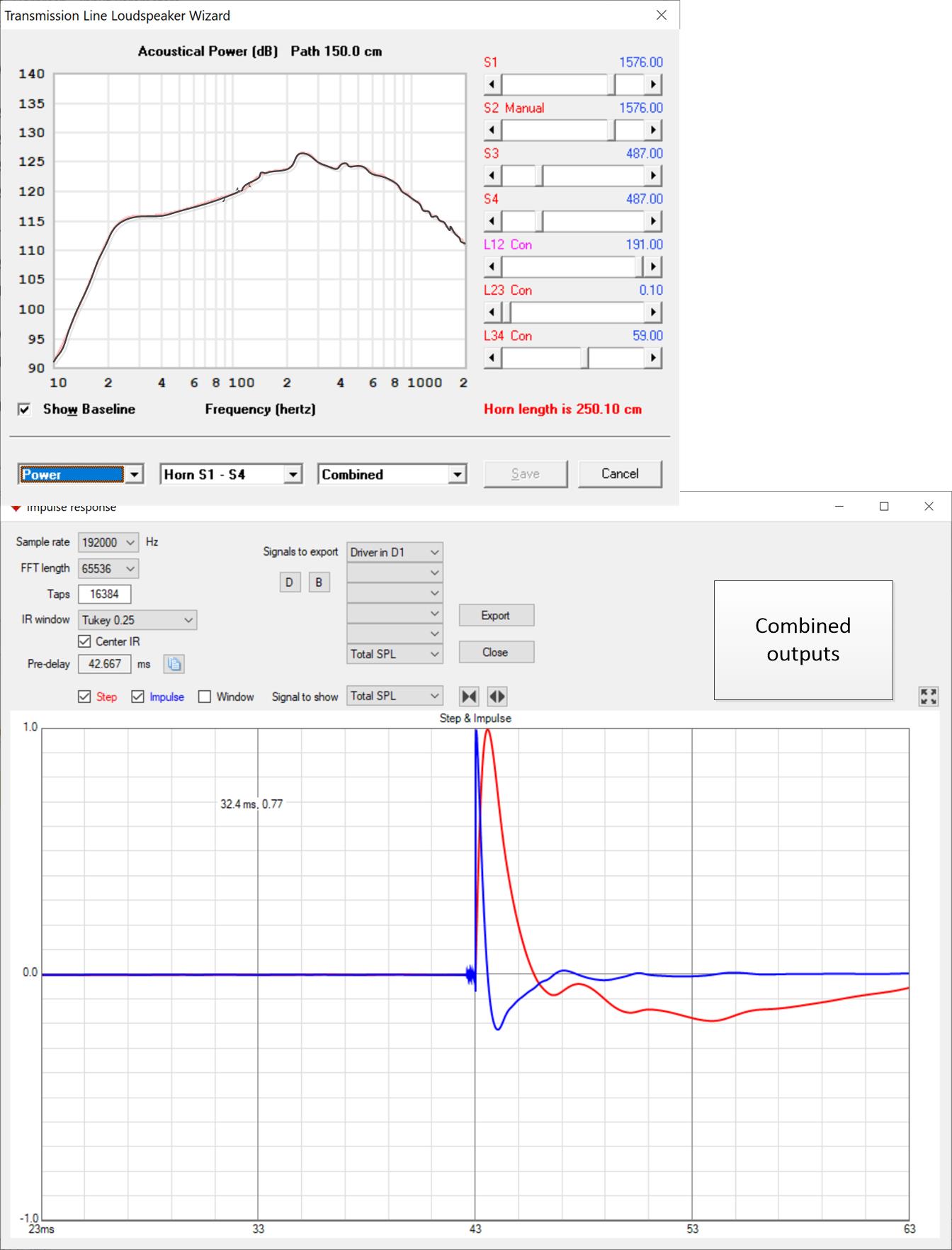
But what about cone and TL exit outputs separately:
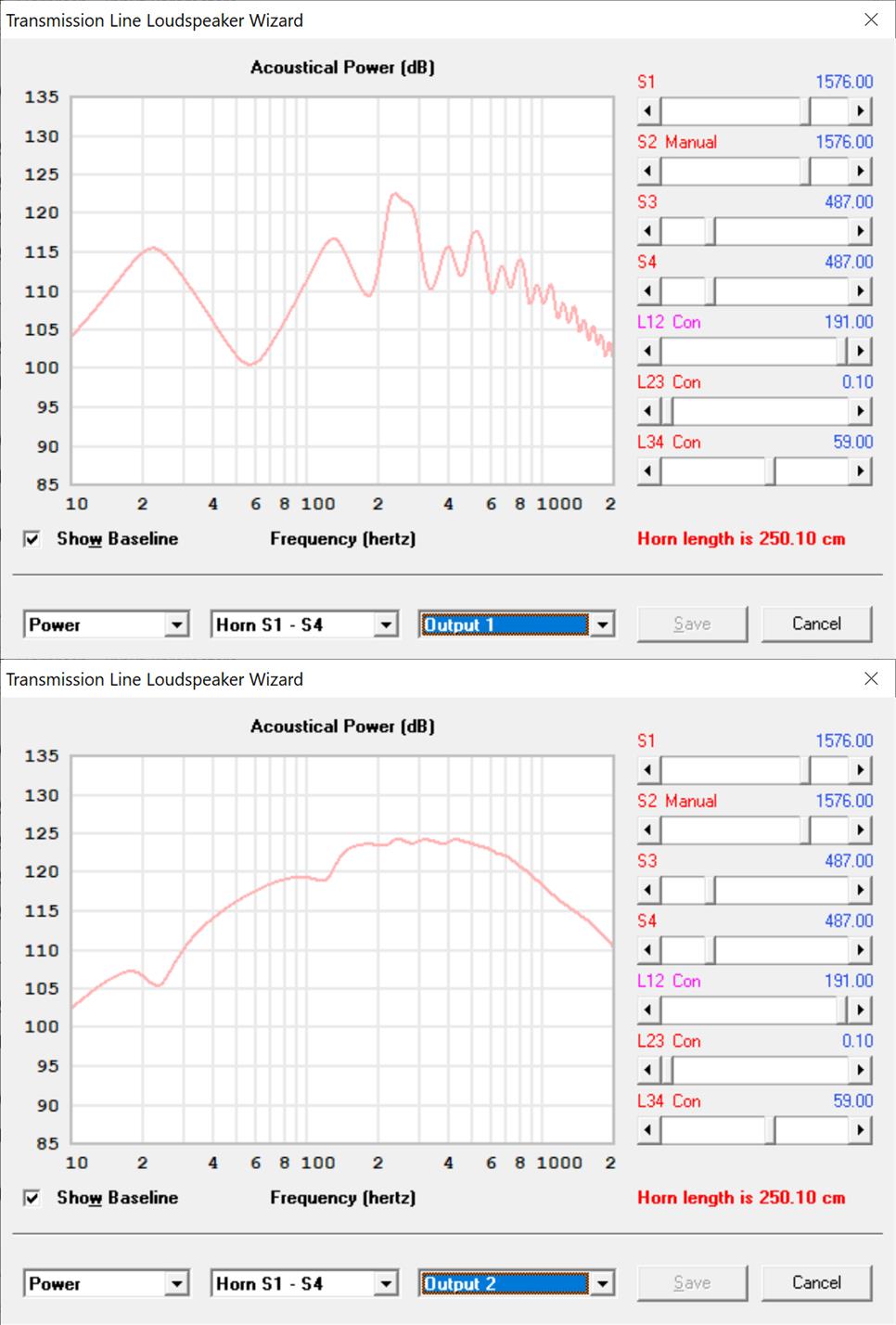
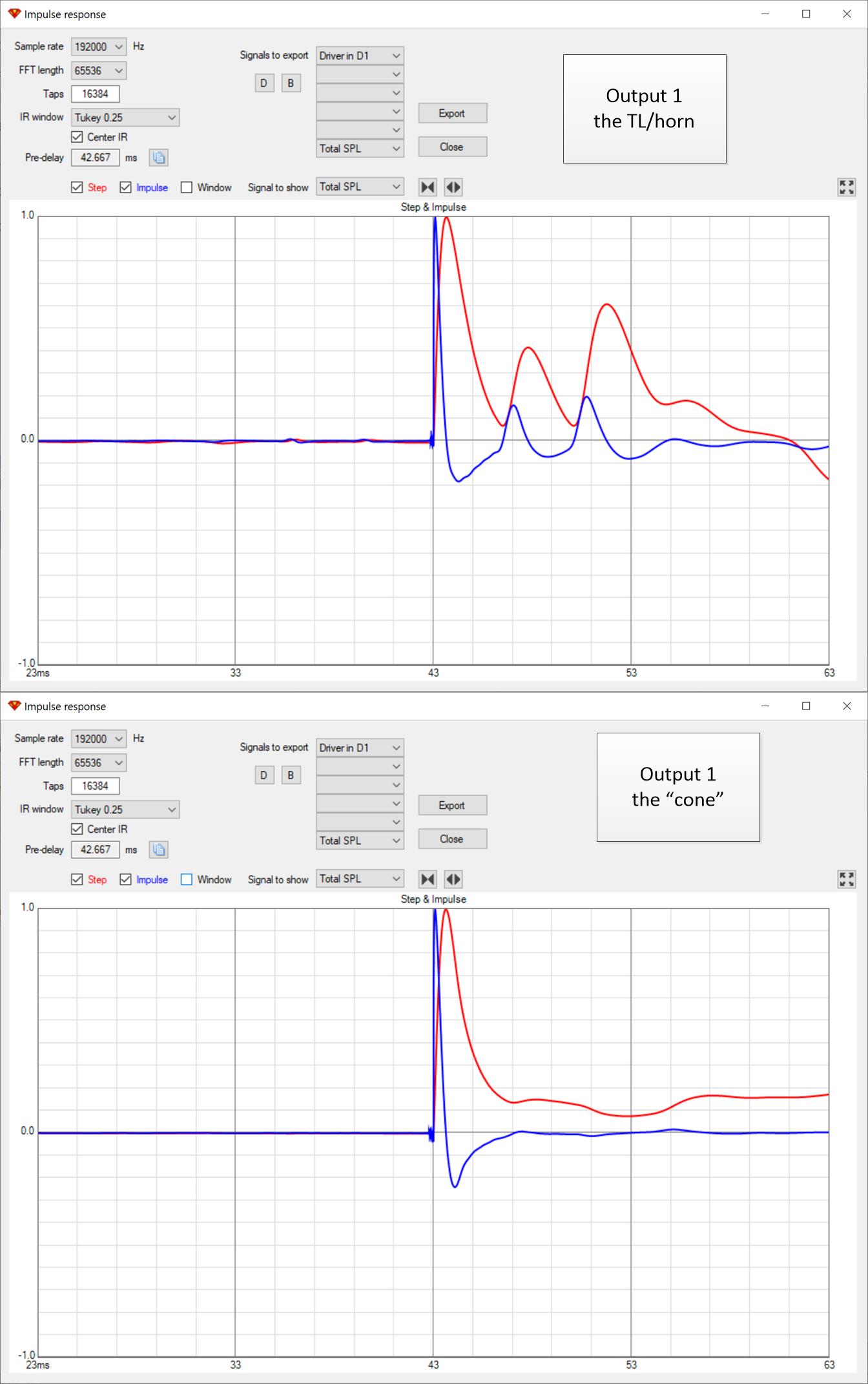
The TL output is above that of the cone only well below 100 Hz. That is the desired result, the TL delays the back side to shift its phase to contribute to the cone where the cone needs help. Above 100 Hz, there is enough output coming from the TL to put small ripples in the cone's output. Perhaps we need more damping to suppress it further.
I also see the TL output coming in 3 pulses - it can't be called minimum phase and might cause issues in XO to AXI.
Hope this helps. Its been fun for me following along.
Apologies in advance to Pano if the images are oversize.
I've been following your TL design with interest, wanting to learn from it, to understand if and where a TL makes sense. This latest one looks pretty good. I've got an HR model going, damped it differently and got a smoother response for what that is worth.
All along I've wanted to look at the time domain response and HR wasn't helpful, except for the undamped line, where the IR and Impulse spectrogram are almost frightening.
How to get IR with damping in the line? I found a way:
*export the FR from the wizard via a screen capture, making sufficient change from the desired baseline so that you get a grey trace instead of red
*drop the screen capture into Vituix's SPL trace tool and trace it (won't trace red) and export
*now point to that exported SPL in the main Vituix screen as a driver frequency response and ask Vituix to show you the IR
Here is what I got and it looks really good:
But what about cone and TL exit outputs separately:
The TL output is above that of the cone only well below 100 Hz. That is the desired result, the TL delays the back side to shift its phase to contribute to the cone where the cone needs help. Above 100 Hz, there is enough output coming from the TL to put small ripples in the cone's output. Perhaps we need more damping to suppress it further.
I also see the TL output coming in 3 pulses - it can't be called minimum phase and might cause issues in XO to AXI.
Hope this helps. Its been fun for me following along.
Apologies in advance to Pano if the images are oversize.
Attachments
- Home
- Loudspeakers
- Multi-Way
- Is it possible to cover the whole spectrum, high SPL, low distortion with a 2-way?
